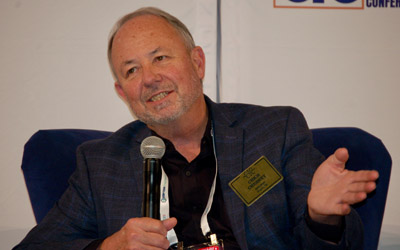"I think the days of sublet with no documentation...is going to change dramatically in the near future,” Frank Terlep said.
Several speakers at the CIECA CONNEX annual conference this fall offered cautions for shops subletting a lot of work, particularly ADAS calibrations. Frank Terlep, vice president of ADAS solutions for Opus IVS, said sublet work suffers now from “a black hole of information.”
“The information that is not being shared about what’s being done on the vehicles is unbelievable,” Terlep said. “So in my opinion, the sublet process, particularly related to ADAS and calibrations, is going to change dramatically. And this is going to happen pretty quickly. The vendors who are doing that sublet work and not documenting what they’re doing? That’s going to end. Because what I’m hearing is the insurers, the payers, don’t know what they’re paying for. You get an invoice that says a calibration for a thousand dollars [but] what does that tell me about what was done to the car? So from my perspective, I think the days of sublet with no documentation, no evidence of what has been done, is going to change dramatically in the near future.”
Chuck Olsen of AirPro Diagnostics agreed.
“If you're going to be doing sublet, make sure that you’ve done your own research,” Olsen said. “Know exactly what needs to be done, and be very specific what it is that you're asking for from that provider. And then ask them for documentation coming back.”
Getting Techs to Read OEM Procedures
During another session at the conference, Chris Chesney, vice president of training for Repairify, said he believes a number of factors can lead technicians to not read and follow OEM repair procedures, including the pressures of flat-rate pay plans and failure by shop management to set standards of performance beyond “expecting the car to be done at 5.”
“There’s one more thing: The OEM service information is written at a very high grade reading level,” Chesney said. “And the majority of technicians in the field weren’t really good readers when they were in school. And so they push back on having to read. When they see the numbers of documents they have to refer to for repair procedures, they shut down and they just put it down and go do it the way they did it on the last car. And so [we need to] leverage technology to bring that information to the technician at the point [they need it], in context that they can understand, in the appropriate order they need to apply it.”
As someone who started as a technician in the industry, Chesney said he encourages all organizations in the industry to “consider the technician in everything you’re doing.”
“Because that’s the person who has to perform and validate the repairs, and without them, none of the rest of it happens,” he said. “And so if we can create technologies that serve them, that make their life easier, more productive and more enjoyable, then we’ll all win.”
Distracted Driving at Record Highs
In what might be viewed as good news for collision repairers, Cornelius Young, senior vice president of product for Cambridge Mobile Telematics, shared data at the conference showing distracted driving, as measured by “moving the [cell] phone around in a vehicle or hitting the screen,” has reached record highs.
“About 58% of trips involve that phone screen interaction, on average for two minutes and 12 seconds per hour of driving per person,” Young said. “And they’re doing it at the riskiest times. About 34% of this is at speeds higher than 50 miles per hour. If you look down at your phone for two seconds [at that speed], you’ve just gone the length of a football field. A lot can happen in that amount of time when you’re on the roads.”
Interestingly, that same percentage---34%---of all the accidents Young’s company has looked at, from the millions of drivers using its crash detection technology, “have active phone distraction 60 seconds prior to the crash, and in some cases, it’s right as the crash is happening.”
Collision repairers planning marketing might want to consider another data point Young shared.
“It might not be a surprise that on the holidays, there’s more distraction,” he said. “So on Labor Day, we’re 5% more distracted versus the other days around Labor Day, and on Thanksgiving, we’re 11% more distracted.”
The Future for Adjustors
During another panel discussion at the CIECA event, Luke Harris, vice president of innovation at USAA, said the work for insurance claims adjusters is changing, but that doesn’t spell the end for that role within auto claims.
“I think about my early job when I was a claims adjuster: I’d get a new claim, I’d take my time to research the file, I’d get my mini-cassette and my tape recorder and I'd get ready to go," Harris said. “And much of that work doesn’t exist anymore. So what you're going to find is you’re still going to need adjusters. You may not need as many, but the cognitive load you’re placing on these adjusters [is tougher] when everything they do all day is making tough decisions throughout the claim process. Because you’re automating the simple claims end-to-end, or the simple tasks that they do today. So it’s going to be a much more specialized, demanding role in the future, even more so than today. But they’re not going away.”















John Yoswick